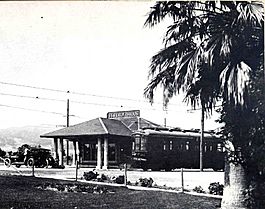Hollywood Line facts for kids
Quick facts for kids Hollywood |
|
|---|---|

Beverly Hills station, c. 1915–1920
|
|
| Overview | |
| Owner | Southern Pacific Railroad |
| Locale | Los Angeles |
| Termini | Subway Terminal Building Beverly Hills |
| Stations | 10 |
| Service | |
| Type | Streetcar |
| System | Pacific Electric |
| Operator(s) | Pacific Electric |
| Rolling stock | Steel 600 Class (last used) |
| History | |
| Opened | 1909 |
| Closed | September 26, 1954 |
| Technical | |
| Line length | 11.7 mi (18.8 km) |
| Track gauge | 4 ft 8 1⁄2 in (1,435 mm) standard gauge |
| Old gauge | narrow gauge |
| Electrification | 600 V DC Overhead lines |
The Hollywood Line was a busy streetcar route that ran in Los Angeles for many years. It was part of the Pacific Electric railway system, often called the "Red Cars." This line connected Downtown Los Angeles to famous areas like Hollywood and even Beverly Hills. It was one of the most important routes before the Hollywood Subway opened. The Hollywood Line operated from 1909 until 1953.
Contents
History of the Hollywood Line
The Hollywood Line was created by combining different railway tracks. In 1895, the Pasadena and Pacific Railroad built a section along Sunset Boulevard. This part used a "narrow gauge" track, meaning the rails were closer together than usual.
Later, the Los Angeles Pacific Railway built new sections. In 1905, they opened the Hollywood Cutoff, which made the route more direct. On September 15, 1909, streetcars started using the Hill Street Tunnel. This tunnel made it faster to get to Downtown Los Angeles. That same year, the tracks were changed to "standard gauge," which is a wider, more common track width.
In 1911, the Pacific Electric company took over the line. This was part of a big event called the "Great Merger."
Under Pacific Electric, the streetcars usually ran between the Hill Street Terminal and Gardner Junction. In 1926, some trips started going into the new Subway Terminal Building through the Hollywood Subway. By 1950, all trips on the line ended in the subway.
The service was bought by Metropolitan Coach Lines in 1953. The very last streetcars ran on the Hollywood Line in the early morning of September 26, 1954.
Where the Hollywood Line Went
The Hollywood Line started at the Hill Street Station in Downtown Los Angeles. This station was near the Subway Terminal Building. The Red Cars would leave the station and go onto Hill Street.
The tracks ran north on Hill Street. They went through two tunnels: one under Bunker Hill and another under Fort Moore Hill. These tunnels helped the streetcars avoid busy streets above.
After the tunnels, the line continued west on Sunset Boulevard. It passed through areas like Echo Park. Then, it turned onto Hollywood Boulevard. The line then weaved its way southwest, sometimes on its own special path, to Santa Monica Boulevard.
Finally, the line ended at the Pacific Electric station in Beverly Hills. This station was on Canon Drive.
Main Stations Along the Way
Here are some of the important stations on the Hollywood Line:
| Station | Major connections | Date opened | Date closed | City |
|---|---|---|---|---|
| Beverly Hills | Coldwater Canyon, Sawtelle, Venice via Hollywood, Westgate | 1902 | 1954 | Beverly Hills |
| Sherman | Sherman, Venice via Hollywood | 1902 | 1955 | West Hollywood |
| Crescent | Sherman, Venice via Hollywood | 1902 | 1955 | Los Angeles |
| Gardner Junction | Laurel Canyon | 1902 | 1955 | |
| Hollywood | Western and Franklin Avenue | 1902 | 1955 | |
| Sunset Junction | Owensmouth, San Fernando, Sherman, Venice via Hollywood, Western and Franklin Avenue | 1902 | 1955 | |
| Subway Terminal Building | Echo Park Avenue, Glendale–Burbank, Owensmouth, Redondo Beach via Playa del Rey, San Fernando, Sawtelle, Sherman, Venice Short Line, Venice via Hollywood, Western and Franklin Avenue, Westgate | 1925 | 1955 | |
The Streetcars Used
The streetcars used on the Hollywood Line were called "Class 600" cars. These cars were assigned to this route starting in 1924.
Venice via Hollywood Line
There was a special service called the Venice via Hollywood Line. This line went all the way from Hollywood to Venice after passing through Beverly Hills. These streetcars started running from the Subway Terminal Building in August 1928. This service ended in August 1941.
Shuttle Routes
The Hollywood Line also had a few smaller "shuttle" routes that connected to it:
- Coldwater Canyon ran from Beverly Hills station to the Beverly Hills Hotel. This shuttle started in 1907 and stopped running in 1923.
- Laurel Canyon ran from Gardner Junction to the start of Laurel Canyon. This line was originally a steam train route. It became a shuttle route in 1921 and was closed in 1924.

